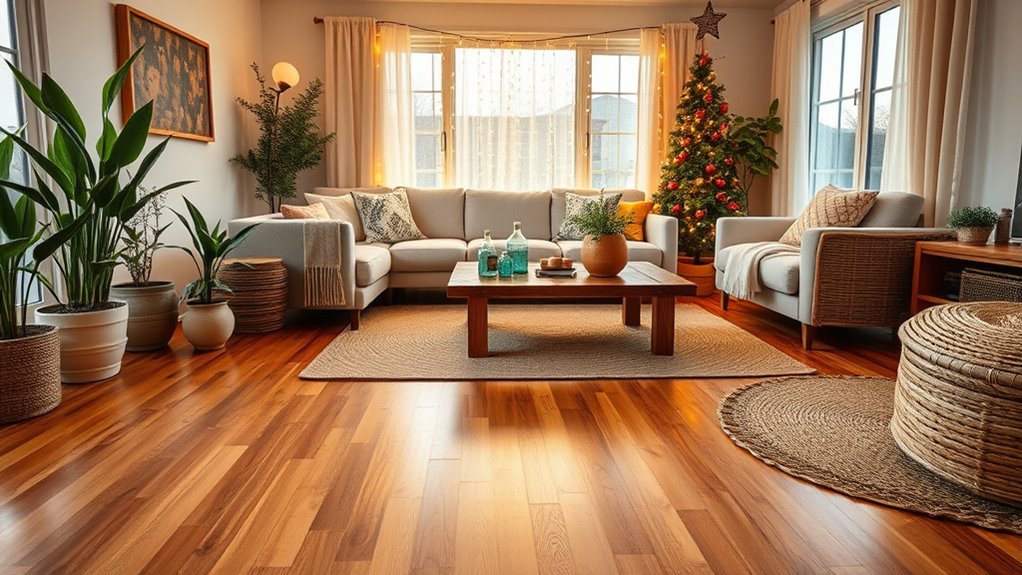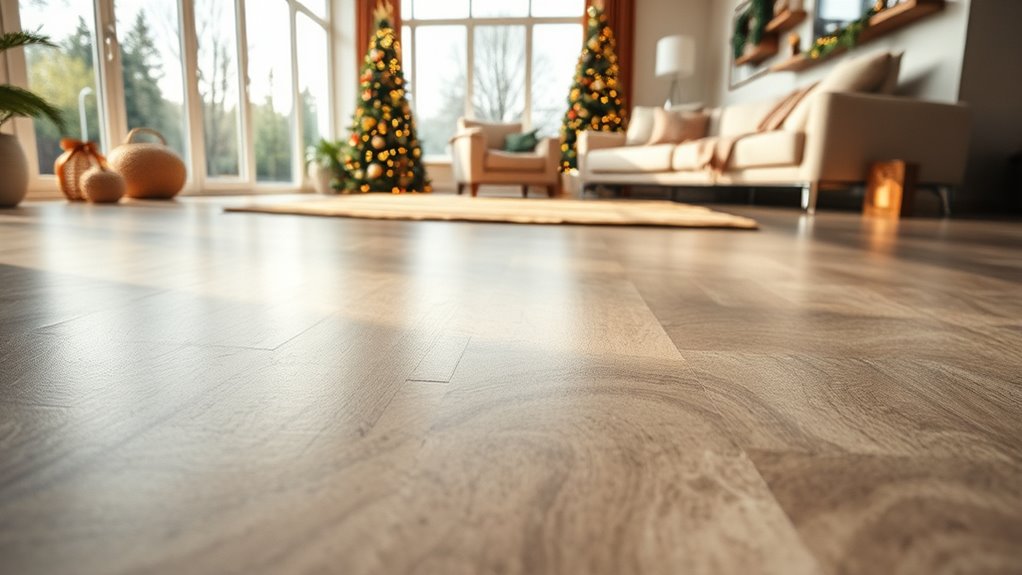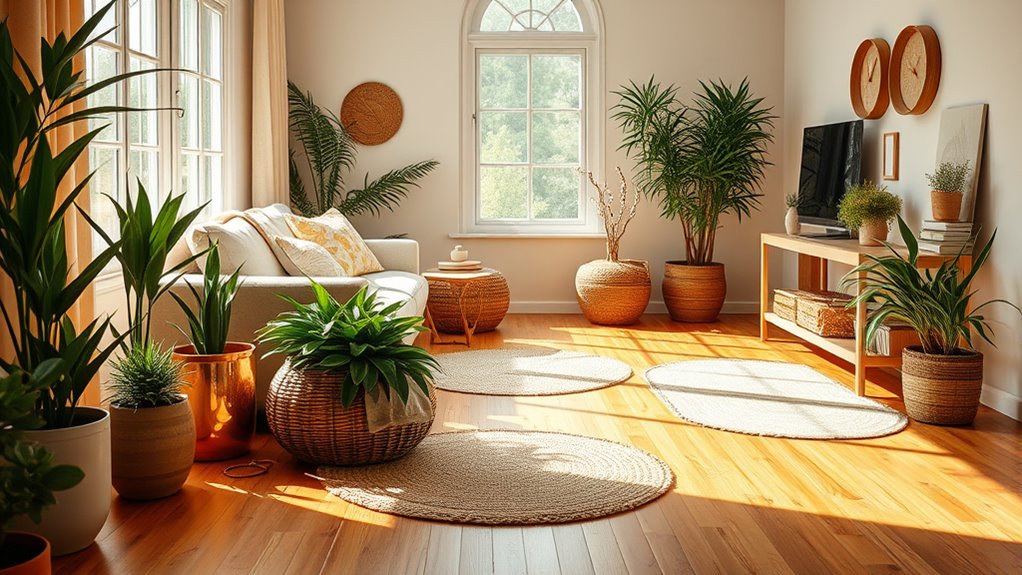When choosing earth-friendly flooring before holiday hosting, opt for sustainable options like reclaimed wood, cork, bamboo, or recycled-content materials. These choices reduce environmental impact, improve indoor air quality, and offer durability for busy gatherings. Low-VOC finishes guarantee a healthier space for you and your guests. By selecting eco-friendly flooring, you create a warm, stylish atmosphere that aligns with your sustainability values. Keep exploring to discover practical tips for maintaining these eco-conscious surfaces during holiday festivities.
Key Takeaways
- Select flooring made from sustainable, renewable materials like bamboo or cork to reduce environmental impact.
- Opt for reclaimed or recycled content flooring to minimize resource consumption and support responsible reuse.
- Choose low-VOC or zero-VOC finishes to improve indoor air quality during holiday gatherings.
- Prioritize durable flooring that requires minimal maintenance and replacements, ensuring long-term eco-friendliness.
- Consider eco-certified products to ensure responsible manufacturing practices and sustainability credentials.
Benefits of Eco-Friendly Flooring for Holiday Homes

Choosing eco-friendly flooring for your holiday home offers numerous advantages. First, it reduces your environmental impact by using sustainable materials and decreasing waste. This helps conserve natural resources and lowers emissions during production. Eco-friendly flooring also improves indoor air quality because it’s made without harmful chemicals or volatile organic compounds (VOCs). That means healthier air for your family and guests, especially during guest stays. Additionally, sustainable flooring options often come with durability and longevity, meaning you won’t need to replace them frequently. This saves you money over time and minimizes waste. Moreover, selecting eco-friendly flooring aligns with sustainable building practices, which are increasingly important in modern home design. Incorporating eco-conscious materials can further enhance your home’s sustainability credentials. Choosing flooring made from renewable resources supports environmental preservation and reduces reliance on finite materials. Furthermore, many eco-friendly flooring options are produced using low-impact manufacturing processes, reducing their overall carbon footprint. Finally, choosing eco-friendly flooring can boost your property’s appeal, attracting environmentally conscious visitors and adding value to your holiday retreat. It’s a simple step that benefits both the planet and your hosting experience.
Reclaimed Wood: Sustainable Elegance for Your Space

Reclaimed wood brings a timeless, rustic charm to your space while supporting sustainability. By choosing reclaimed wood flooring, you utilize wood salvaged from old buildings, barns, or demolished structures, giving it new life and reducing demand for virgin timber. This choice not only adds character and warmth but also minimizes environmental impact. Reclaimed wood often features unique textures and imperfections that lend authentic visual interest to your home. Installing it requires minimal processing, conserving energy and resources. Plus, sourcing reclaimed wood supports responsible forestry practices by recycling existing materials. Its durability means your floors can last for decades, making it a smart, eco-friendly investment. Additionally, pinball machines with their vintage appeal can serve as unique decorative pieces that complement the reclaimed aesthetic. Before your holiday gathering, reclaimed wood offers a stylish, sustainable foundation that showcases your commitment to both aesthetics and the planet. Furthermore, choosing reclaimed wood can inspire a cohesive design theme that echoes the innovative design trends seen in tiny houses, emphasizing simplicity and sustainability, and also aligns with environmentally conscious sustainable building materials.
Cork Flooring: Comfort and Eco-Consciousness Combined

Cork flooring offers a natural, comfortable surface that complements the sustainability benefits of reclaimed wood. It’s made from the bark of cork oak trees, which regenerates after harvest, making it a renewable resource. You’ll appreciate its softness underfoot, reducing fatigue during long gatherings. Cork also provides excellent insulation, helping you keep your space warm and cozy for holiday guests. Its natural properties resist mold, mildew, and pests, promoting a healthier environment. Plus, cork absorbs sound, minimizing noise during busy festivities. Installation is straightforward, and many cork floors come with eco-friendly finishes that don’t emit harmful chemicals. By choosing cork, you’re making a conscious decision to prioritize comfort and sustainability—perfect for hosting confidently while reducing your environmental footprint. Additionally, cork’s sustainable material, derived from the bark of cork oak trees, ensures that your flooring choice supports environmental conservation efforts. Incorporating cork flooring can also enhance indoor air quality, making your home more inviting for guests. Furthermore, cork’s thermal insulation properties contribute to energy efficiency by maintaining consistent indoor temperatures.
Bamboo Flooring: Rapid Growth and Renewability

Bamboo flooring benefits from a remarkably fast growth cycle, allowing it to be harvested sustainably without depleting resources. When combined with eco-friendly manufacturing practices, it becomes a smart choice for environmentally conscious homeowners. By choosing bamboo, you’re supporting a renewable material that minimizes environmental impact. Additionally, bamboo’s rapid growth rate enables more frequent harvesting, further reducing strain on natural ecosystems. Implementing sustainable harvesting methods ensures that bamboo remains a viable offensive security measure for future use.
Fast Growth Cycle
Because bamboo grows so quickly, it’s one of the most sustainable flooring options available. Its fast growth cycle means you can harvest mature plants in just 3 to 5 years, compared to hardwoods that take decades. This rapid renewal guarantees a plentiful supply without depleting natural resources. Here are three key advantages of bamboo’s quick growth:
- Reduced Environmental Impact: Faster harvesting means less land is needed, minimizing deforestation.
- Efficient Use of Resources: Bamboo absorbs carbon dioxide quickly, helping combat climate change.
- Consistent Supply: Its quick growth ensures a steady availability, making it a reliable flooring choice.
- Protecting forests from overharvesting and reducing deforestation is crucial for maintaining biodiversity and ecosystem health. Additionally, bamboo’s ability to regrow rapidly after harvesting further supports sustainable use and resource conservation. Its quick growth cycle also helps prevent overexploitation compared to slower-growing hardwoods, making bamboo an even more earth-friendly option. Moreover, bamboo’s ability to revive quickly after harvesting minimizes environmental disturbance and supports ongoing sustainable practices. The rapid growth cycle of bamboo, combined with its renewability, makes it an ideal choice for environmentally conscious homeowners, especially during the busy holiday season.
Sustainable Harvesting Practices
While bamboo’s rapid growth makes it a sustainable choice, responsible harvesting practices are vital to maintaining its renewability. When harvesting bamboo, you need to make certain it’s done selectively, removing mature stalks without damaging the plant’s root system. This approach allows new shoots to grow naturally, keeping the bamboo forest healthy and productive. Overharvesting or cutting too many stalks at once can weaken the plants and slow regeneration. Sustainable harvesters also stagger their collection cycles, giving bamboo time to recover. Proper harvesting techniques help preserve biodiversity and prevent soil erosion, guaranteeing bamboo remains a reliable resource. Additionally, understanding narcissistic behavior can be important when dealing with suppliers to ensure ethical and responsible practices. By choosing suppliers that prioritize these practices, you support bamboo’s ongoing growth and contribute to a more eco-friendly flooring option for your home. Implementing regenerative harvesting methods ensures the long-term sustainability of bamboo resources for future generations. Moreover, adopting ethical sourcing standards ensures that harvesting remains environmentally and socially responsible.
Eco-Friendly Manufacturing
Eco-friendly manufacturing processes play a crucial role in ensuring that bamboo flooring remains a sustainable choice. When selecting bamboo flooring, look for brands that prioritize eco-conscious methods. These include:
- Using low-VOC adhesives and finishes to reduce harmful emissions.
- Employing sustainable harvesting techniques that minimize waste and energy use.
- Implementing efficient milling practices that conserve water and power.
- Choosing products with certified eco-friendly finishes that further reduce environmental impact.
- Incorporating automation in manufacturing to optimize resource use and decrease waste.
Recycled Content Vinyl and Linoleum Options

Recycled content vinyl and linoleum give you sustainable options that make good use of existing materials. They’re known for their durability and easy maintenance, making them practical choices for busy spaces. Plus, their design versatility means you can find styles that fit any aesthetic.
Eco-Friendly Material Sources
Have you considered flooring options that make use of recycled materials? Recycled content vinyl and linoleum are excellent eco-friendly choices. These materials reduce waste and lower environmental impact by repurposing existing resources. For example:
- Recycled vinyl planks incorporate post-consumer plastics, minimizing landfill waste.
- Linoleum made from recycled linseed oil, wood flour, and cork offers sustainable sourcing.
- Some manufacturers use recycled rubber or vinyl backing to enhance durability and eco-friendliness.
Choosing these options supports waste reduction and promotes renewable materials. They often come with certifications like GreenGuard or EcoLabel, ensuring environmentally responsible manufacturing. By selecting recycled content flooring, you contribute to a healthier planet while preparing for your holiday gathering.
Durability and Maintenance
When properly installed and maintained, recycled content vinyl and linoleum flooring can provide impressive durability for your household or commercial space. These materials are designed to withstand daily wear and tear, making them ideal for busy areas. Vinyl flooring, especially, offers resistance to scratches, stains, and moisture, which simplifies cleaning and upkeep. Linoleum is naturally resilient and resists dents and scuffs, requiring only regular sweeping and occasional mopping. Both options benefit from simple maintenance routines; avoid harsh chemicals to preserve their eco-friendly qualities. Over time, you might need to replace worn sections, but overall, these floors hold up well with minimal effort. Choosing recycled content options means you’re investing in long-lasting flooring that’s both sustainable and practical for your space.
Design Versatility Options
Thanks to their innovative production processes, recycled content vinyl and linoleum flooring now offer a wide range of design options to suit any aesthetic. You can choose from vibrant patterns, subtle textures, or realistic visuals that mimic natural materials. These flooring types allow you to customize your space without sacrificing style or sustainability.
Here are some options to contemplate:
- Bold, colorful patterns that make a statement in any room
- Natural-looking textures that resemble stone or wood
- Minimalist designs for a sleek, modern look
With so many choices, you can easily find flooring that complements your decor while supporting eco-friendly practices, making your holiday hosting both stylish and sustainable.
Low-VOC and Non-Toxic Finishes for a Healthy Home

Choosing the right finishes for your flooring is essential to creating a healthy indoor environment. Low-VOC and non-toxic finishes release fewer harmful chemicals, ensuring better air quality for you and your guests. These finishes are made without volatile organic compounds, which often cause headaches, allergies, or respiratory issues. When selecting a finish, look for labels like “Zero VOC” or “Low VOC” to guarantee safety.
| Finish Type | Benefits | Application Tips |
|---|---|---|
| Water-based | Quick-drying, low odor | Use in well-ventilated areas |
| Natural Oil | Enhances wood’s natural look | Reapply periodically |
| Plant-based | Eco-friendly, non-toxic | Follow manufacturer instructions |
| Wax | Adds a soft sheen | Apply thin coats for durability |
Maintenance Tips for Sustainable Flooring Materials

Maintaining sustainable flooring materials requires regular, gentle care to preserve their eco-friendly qualities. Proper upkeep guarantees they stay beautiful and last longer. Here are some essential tips:
- Use soft brushes or vacuum with a gentle attachment to remove dirt without scratching surfaces.
- Mop with a damp cloth and mild, eco-friendly cleaner—avoid harsh chemicals that can damage finishes or harm the environment.
- Place doormats at entryways to reduce dirt and debris tracked inside, minimizing wear and tear.
Making the Right Choice for Your Holiday Hosting Needs

Preparing your flooring for holiday hosting means selecting the right materials that combine style, durability, and eco-friendliness. Think about how your space will be used—will there be lots of foot traffic or spilled drinks? Opt for flooring that can withstand wear yet looks inviting. Bamboo and cork are excellent choices, as they’re sustainable and resilient. If you prefer a classic look, reclaimed hardwood adds charm and eco-conscious appeal. Consider maintenance needs; easy-to-clean surfaces save time during busy gatherings. Also, choose colors and textures that complement your décor and create a warm, welcoming atmosphere. By making thoughtful choices now, you’ll ensure your home is both stylish and environmentally friendly, providing a perfect setting for memorable holiday moments with family and friends.
Frequently Asked Questions
How Do Eco-Friendly Flooring Options Compare in Durability to Traditional Flooring?
Eco-friendly flooring options often match or even surpass traditional flooring in durability. Materials like bamboo, cork, and reclaimed wood are surprisingly resilient and can withstand daily wear. Plus, they tend to be easier to maintain and repair. While some eco-friendly choices might seem less sturdy initially, advancements in manufacturing have improved their longevity. So, you can confidently select sustainable flooring without sacrificing durability or style.
Are There Cost Differences Between Eco-Friendly and Conventional Flooring Materials?
Imagine walking into a warm, inviting room where your flooring not only looks beautiful but also saves you money. Eco-friendly flooring options often cost a bit more upfront than conventional choices, but they can save you money long-term through durability and energy efficiency. You’ll also benefit from lower maintenance costs and a healthier home environment. So, while the initial investment might be higher, the long-term savings make eco-friendly flooring a smart choice.
Can Eco-Friendly Flooring Be Installed Over Existing Surfaces Easily?
Eco-friendly flooring can often be installed over existing surfaces, making the process easier and more convenient. You’ll want to check the type of flooring you have and guarantee it’s suitable for overlay installation. Many eco-friendly options, like bamboo or cork, are designed for easy installation over existing floors, saving you time and effort. Just make sure to prepare the surface properly and follow manufacturer instructions for a smooth, eco-conscious upgrade.
What Is the Lifespan of Sustainable Flooring Options in High-Traffic Areas?
When considering the lifespan of sustainable flooring in high-traffic areas, you want durability that lasts. Many eco-friendly options, like bamboo or cork, can endure years of wear if properly maintained. You should expect a lifespan of 10-25 years, depending on material quality and usage. Regular cleaning and protective coatings extend their life, so you can enjoy eco-conscious flooring that holds up well, even in busy spaces.
How Do I Ensure the Flooring I Choose Is Truly Environmentally Responsible?
You might think choosing eco-friendly flooring is simple, but many options hide environmental costs. To guarantee you’re genuinely responsible, research certifications like FSC or GreenGuard. Ask about the materials’ sourcing and manufacturing processes. Avoid those with harmful chemicals or excessive waste. By doing your homework, you’ll find flooring that’s not just stylish but also kind to the planet—making your holiday hosting truly eco-conscious and impressive.
Conclusion
By choosing eco-friendly flooring, you create a healthier home and a happier holiday. From reclaimed riches to resilient bamboo, sustainable surfaces shine with style and substance. Make mindful choices that minimize mess and maximize merriment. With the right sustainable surface, you’ll host with heart, harmony, and happiness. So, select smart, style sustainably, and celebrate the season with a space that’s both beautiful and environmentally balanced. Your eco-conscious hosting begins with the perfect flooring decision!









